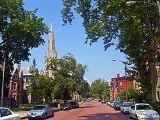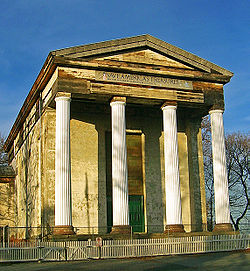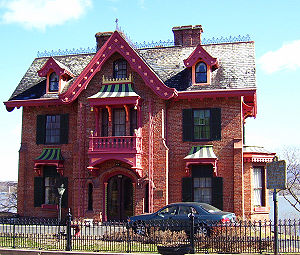
Montgomery-Grand-Liberty Streets Historic District
Encyclopedia
The Montgomery-Grand-Liberty Streets Historic District
was the first of two to be designated in the city of Newburgh
, New York
, USA. It runs along the three named north-south streets in the northeast quadrant of the city and includes 250 buildings in its 1010 acres (4.1 km²).
Much of the district's historical character comes from its historic homes, dating to the 19th century. Many were built by local industrialists to take advantage of the views over the Hudson River
available from the neighborhood. Some incorporated groundbreaking design trends pioneered by Newburgh native Andrew Jackson Downing
, making the area important in architectural history
. It was thus added to the National Register of Historic Places
in 1973. Three contributing properties
— the David Crawford House
, Old Town Cemetery, and Newburgh's main post office — are separately listed on the Register, and one, the Dutch Reformed Church
, has been recognized as a National Historic Landmark
.
ists in the city worried about the effects of urban renewal
on a neglected asset. The Dutch Reformed Church had only recently been saved from demolition after almost a decade of vacancy; before that, the Crawford House had come close to being bulldozed for a school parking lot.
 In 1977, the city council enlarged the district greatly and renamed it the East End Historic District
In 1977, the city council enlarged the district greatly and renamed it the East End Historic District
, including Washington's Headquarters State Historic Site
and other buildings in the neighborhoods south of Broadway. It established a zoning code to maintain a consistent appearance of new construction in the district and a seven-member Architectural Review Commission to enforce it. In 1985 a smaller version of the East End district was listed separately on the National Register.
Some of the urban decay
and blight that has been a problem in that district is visible within the Montgomery-Grand-Liberty corridor. The most visible example is the cobblestone
surface of Liberty Street, neglected for many years and frequently cut open by local utility
companies for repairs and resurfaced with asphalt
. The city has restored it in patches and would like to do the entire street, but lacks the money.
Many of the homes in the district (particularly the northern blocks) have been attractive to new residents who have often renovated them. Much of the district retains its original character of a leafy residential neighborhood.

), the 1842 Orange County courthouse designed by Thornton Niven (a copy of his contemporary Goshen courthouse
), the gambrel-roofed Selah Reeve House that carried Newburgh and the Hudson far and wide on a popular piece of 18th-century kitchenware, and many of Newburgh's oldest churches.
Historic district
A historic district or heritage district is a section of a city which contains older buildings considered valuable for historical or architectural reasons. In some countries, historic districts receive legal protection from development....
was the first of two to be designated in the city of Newburgh
Newburgh (city), New York
Newburgh is a city located in Orange County, New York, United States, north of New York City, and south of Albany, on the Hudson River. Newburgh is a principal city of the Poughkeepsie-Newburgh-Middletown metropolitan area, which includes all of Dutchess and Orange counties. The Newburgh area was...
, New York
New York
New York is a state in the Northeastern region of the United States. It is the nation's third most populous state. New York is bordered by New Jersey and Pennsylvania to the south, and by Connecticut, Massachusetts and Vermont to the east...
, USA. It runs along the three named north-south streets in the northeast quadrant of the city and includes 250 buildings in its 1010 acres (4.1 km²).
Much of the district's historical character comes from its historic homes, dating to the 19th century. Many were built by local industrialists to take advantage of the views over the Hudson River
Hudson River
The Hudson is a river that flows from north to south through eastern New York. The highest official source is at Lake Tear of the Clouds, on the slopes of Mount Marcy in the Adirondack Mountains. The river itself officially begins in Henderson Lake in Newcomb, New York...
available from the neighborhood. Some incorporated groundbreaking design trends pioneered by Newburgh native Andrew Jackson Downing
Andrew Jackson Downing
Andrew Jackson Downing was an American landscape designer, horticulturalist, and writer, a prominent advocate of the Gothic Revival style in the United States, and editor of The Horticulturist magazine...
, making the area important in architectural history
History of architecture
The history of architecture traces the changes in architecture through various traditions, regions, overarching stylistic trends, and dates.-Neolithic architecture:Neolithic architecture is the architecture of the Neolithic period...
. It was thus added to the National Register of Historic Places
National Register of Historic Places
The National Register of Historic Places is the United States government's official list of districts, sites, buildings, structures, and objects deemed worthy of preservation...
in 1973. Three contributing properties
Contributing property
In the law regulating historic districts in the United States, a contributing resource or contributing property is any building, structure, or object which adds to the historical integrity or architectural qualities that make the historic district, listed locally or federally, significant...
— the David Crawford House
David Crawford House
The David Crawford House is located on Montgomery Street in Newburgh, New York, USA. It is a neoclassical mansion built by Crawford, who had made his fortune in Hudson River shipping, in 1834....
, Old Town Cemetery, and Newburgh's main post office — are separately listed on the Register, and one, the Dutch Reformed Church
Dutch Reformed Church (Newburgh, New York)
The Dutch Reformed Church is one of the most prominent architectural landmarks in Newburgh, New York. It was designed by Alexander Jackson Davis in 1835 in the Greek Revival style common in America in that time period. It is his only surviving church in that style and is considered to be his latest...
, has been recognized as a National Historic Landmark
National Historic Landmark
A National Historic Landmark is a building, site, structure, object, or district, that is officially recognized by the United States government for its historical significance...
.
History
The district was defined and recognized by the city, then the state and finally the National Register when historic preservationHistoric preservation
Historic preservation is an endeavor that seeks to preserve, conserve and protect buildings, objects, landscapes or other artifacts of historical significance...
ists in the city worried about the effects of urban renewal
Urban renewal
Urban renewal is a program of land redevelopment in areas of moderate to high density urban land use. Renewal has had both successes and failures. Its modern incarnation began in the late 19th century in developed nations and experienced an intense phase in the late 1940s – under the rubric of...
on a neglected asset. The Dutch Reformed Church had only recently been saved from demolition after almost a decade of vacancy; before that, the Crawford House had come close to being bulldozed for a school parking lot.

East End Historic District (Newburgh, New York)
The East End Historic District in Newburgh, New York, USA is the lower portion of what the state and city recognize as a single historic district along with the Montgomery-Grand-Liberty Streets Historic District...
, including Washington's Headquarters State Historic Site
Washington's Headquarters State Historic Site
Washington's Headquarters State Historic Site is a historic site in Newburgh, New York, USA. It consists of the Hasbrouck House, the longest-serving headquarters of George Washington during the American Revolutionary War, and three other structures....
and other buildings in the neighborhoods south of Broadway. It established a zoning code to maintain a consistent appearance of new construction in the district and a seven-member Architectural Review Commission to enforce it. In 1985 a smaller version of the East End district was listed separately on the National Register.
Some of the urban decay
Urban decay
Urban decay is the process whereby a previously functioning city, or part of a city, falls into disrepair and decrepitude...
and blight that has been a problem in that district is visible within the Montgomery-Grand-Liberty corridor. The most visible example is the cobblestone
Cobblestone
Cobblestones are stones that were frequently used in the pavement of early streets. "Cobblestone" is derived from the very old English word "cob", which had a wide range of meanings, one of which was "rounded lump" with overtones of large size...
surface of Liberty Street, neglected for many years and frequently cut open by local utility
Public utility
A public utility is an organization that maintains the infrastructure for a public service . Public utilities are subject to forms of public control and regulation ranging from local community-based groups to state-wide government monopolies...
companies for repairs and resurfaced with asphalt
Asphalt
Asphalt or , also known as bitumen, is a sticky, black and highly viscous liquid or semi-solid that is present in most crude petroleums and in some natural deposits, it is a substance classed as a pitch...
. The city has restored it in patches and would like to do the entire street, but lacks the money.
Many of the homes in the district (particularly the northern blocks) have been attractive to new residents who have often renovated them. Much of the district retains its original character of a leafy residential neighborhood.

Contributing properties
In addition to the four noted above, the district is also home to the Warren House, considered a textbook example of the villa-style house advocated by Downing (although designed by Calvert VauxCalvert Vaux
Calvert Vaux , was an architect and landscape designer. He is best remembered as the co-designer , of New York's Central Park....
), the 1842 Orange County courthouse designed by Thornton Niven (a copy of his contemporary Goshen courthouse
1841 Goshen Courthouse
The 1841 Goshen Courthouse is located along Main Street in the center of Goshen, New York, the seat of Orange County, New York, USA. It was designed by popular local architect Thornton Niven in a Greek Revival style, meant to be a twin of the one he had already built in Newburgh, which at that...
), the gambrel-roofed Selah Reeve House that carried Newburgh and the Hudson far and wide on a popular piece of 18th-century kitchenware, and many of Newburgh's oldest churches.
External links
- Orange County Courthouse, Second & Grand Streets, Newburgh, Orange, NY: 10 photos, 1 data page, and 1 photo caption page at Historic American Building Survey
- David Crawford House, 189 Montgomery Street, Newburgh, Orange, NY: 10 photos, 2 data pages, and 1 photo caption page at Historic American Building Survey
- Reeve House, 129-131 Montgomery Street, Newburgh, Orange, NY: 10 drawings, 7 photos, 1 data page, and 1 photo caption page at Historic American Building Survey
- William Roe House, 160 Grand Street, Newburgh, Orange, NY: 15 photos, 5 data pages, and 1 photo caption page at Historic American Building Survey
- Halsey Stevens House, 182 Grand Street, Newburgh, Orange, NY: 9 photos, 4 data pages, and 1 photo caption page at Historic American Building Survey
- William C. Hasbrouck House, 99 Montgomery Street, Newburgh, Orange, NY: 15 photos, 7 data pages, and 1 photo caption page at Historic American Building Survey
- W. E. Warren House, 196 Grand Street, Newburgh, Orange, NY: 8 photos, 1 data page, and 1 photo caption page at Historic American Building Survey
- Anthony House, 201 Montgomery Street, Newburgh, Orange, NY: 1 photo, 1 data page, and 1 photo caption page at Historic American Building Survey
- City Library, Grand Street, Newburgh, Orange, NY: 5 photos, 1 data page, and 1 photo caption page at Historic American Building Survey
- Dr. William A. M. Culbert House, 120 Grand Street, Newburgh, Orange, NY: 6 photos, 2 data pages, and 1 photo caption page at Historic American Building Survey
- Dutch Reformed Church, 132 Grand Street, Newburgh, Orange, NY: 16 photos, 10 data pages, and 1 photo caption page at Historic American Building Survey
- 78-86 Grand Street (Houses), Newburgh, Orange, NY: 1 photo, 1 data page, and 1 photo caption page at Historic American Building Survey
- 288 Grand Street (House), Newburgh, Orange, NY: 2 photos, 1 data page, and 1 photo caption page at Historic American Building Survey
- Sunflower House, 195 Montgomery Street, Newburgh, Orange, NY: 2 photos, 1 data page, and 1 photo caption page at Historic American Building Survey
- Halsey Stevens Carriage House, Newburgh, Orange, NY: 1 photo, 1 data page, and 1 photo caption page at Historic American Building Survey

